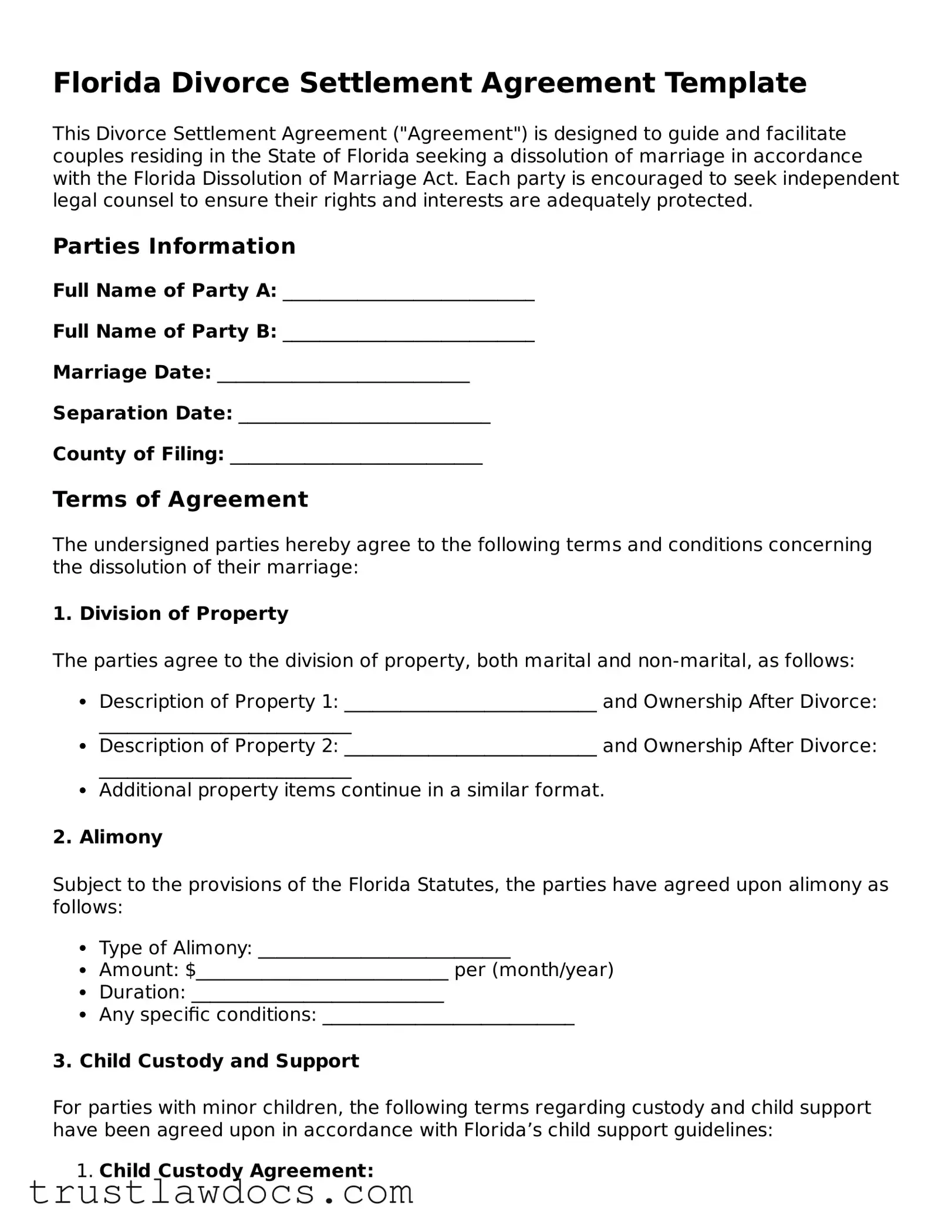1. What is a Florida Divorce Settlement Agreement?
A Florida Divorce Settlement Agreement is a legally binding document that outlines the terms and conditions agreed upon by both parties in a divorce. This agreement covers a range of important issues, including the division of assets and liabilities, child support, custody arrangements, and alimony. Once executed, it binds both parties to its terms and conditions and is enforceable by law.
2. Who needs to fill out a Florida Divorce Settlement Agreement form?
Any divorcing couple in the state of Florida seeking to formalize the terms of their separation in a written agreement needs to fill out a Florida Divorce Settlement Agreement form. This document is especially important for couples who wish to avoid going to court and prefer to come to an agreement through negotiation or mediation.
3. Can we draft a Florida Divorce Settlement Agreement without a lawyer?
Yes, it's possible to draft a Florida Divorce Settlement Agreement without a lawyer. However, it's highly advisable to consult with a legal professional. This ensures that the agreement complies with Florida laws and that both parties' rights are protected. A lawyer can also help address complex issues like property division, child custody, and support obligations in a manner that is fair and legally sound.
4. What happens if we cannot agree on the terms of the Divorce Settlement Agreement?
If both parties cannot agree on the terms of the Divorce Settlement Agreement, the next step is usually mediation. If mediation doesn't resolve the disagreements, the divorce case may proceed to court, where a judge will make decisions on the contested issues. This process can be longer and more costly than reaching an agreement outside of court.
5. Are the terms of a Florida Divorce Settlement Agreement final?
Yes, once a Florida Divorce Settlement Agreement is signed by both parties and approved by a judge, its terms are final and legally binding. However, under certain circumstances, such as a significant change in one party's financial situation, the agreement can be modified through a formal request to the court.
6. How do we file a Florida Divorce Settlement Agreement?
After drafting and signing the Florida Divorce Settlement Agreement, it must be filed with the clerk of the court handling the divorce proceedings. This is typically done at the same time as the filing for divorce itself. The court will review the agreement to ensure it's fair and complies with Florida law before incorporating it into the final divorce decree.
7. What should be included in a Florida Divorce Settlement Agreement?
A comprehensive Florida Divorce Settlement Agreement should include details on the division of all marital assets and liabilities, arrangements for child support and custody, alimony details, and any other relevant terms that the parties agree upon. It should also include both parties' full names, addresses, and the date of the marriage and separation.
8. How is child custody determined in a Florida Divorce Settlement Agreement?
In Florida, the primary consideration for determining child custody arrangements in a Divorce Settlement Agreement is the child's best interests. Factors such as the parents' mental and physical health, the child's relationship with each parent, the parents' ability to provide for the child, and the child's home, school, and community record are all taken into account.
9. Can alimony be included in the agreement?
Yes, alimony (also known as spousal support) can be included in a Florida Divorce Settlement Agreement. The agreement should specify the type, amount, and duration of alimony payments, reflecting considerations such as the length of the marriage, each party's financial status, and their respective needs and abilities to pay.
10. Is a Florida Divorce Settlement Agreement subject to approval by a judge?
Yes, after both parties sign the Florida Divorce Settlement Agreement, it must be submitted to a court. The judge will review the agreement to ensure that it is fair, just, and complies with Florida law before incorporating it into the final divorce decree. Only after a judge's approval does the agreement become legally binding.
